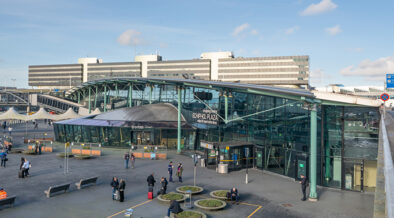
We discover more about how the Royal Schiphol Group is building design resilience into all new facilities at Amsterdam Schiphol Airport.
The resilience of an airport is tested daily – whether operational, climate, social or economic. There are numerous tools and technologies available to help create future-ready airports.
In this article, we explore how one airport is doing just that. Esther Kromhout (EK), managing director of NACO, speaks with the Royal Schiphol Group’s head of airport development, Marianne van Scherpenzeel (MS).
EK: What do you understand by resilience-by-design at Schiphol, and why is it so important?
MS: It’s about flexibility and being able to cope with all the future challenges that we will face. The current political situation brings uncertainty for us. If we combine this with technological developments, as I sit here today, we need to stay focused on what does the future of flying looks like.
Are we going to see more electric flight? Are we going to fly on hydrogen? Or even something else which we don’t know about yet?
With so many unknowns, the only thing we can do is make sure we build resilience and flexibility into our future plans.
EK: Similarly, for me, resilience-by-design is not only about designing airports that withstand climate change, but it must also encompass operational, infrastructure, financial and social resilience. And the means to achieving that is indeed building in flexibility and looking at scenarios.
MS: And I think we must look at an airport from all these angles. Climate resilience is certainly something that we’re looking at, besides working on sustainability. What is it that we have to do to be resilient when it comes to water quality, water quantity, or heat stress?
At the same time, we are also looking closely at working conditions at our airport. How do we make sure we have a sustainable future for our workers? We are looking at how we can relieve physical strain in the baggage basement, how we should incorporate automated systems that don’t exist yet, as well as improving air quality on the airside.
EK: You mentioned baggage handling here. When it comes to operational resilience, could you tell us a bit about Schiphol’s one roof terminal concept and how it allows you to make changes in line with demand?
Throughout 2024 NACO celebrated our 75th anniversary and we thought back to colleagues that were involved in the original plans for the one roof terminal.
MS: The one roof terminal concept really helps us because it’s much easier to have an overflow from one area to another.
If Terminal One’s departures hall becomes really congested, for example, then we can easily move operations to Terminal Three and have people check in there. Keeping all facilities under one roof helps us make the connections for our passengers and airlines and builds resilience at the same time.
To give another example, our transfer filter is right next to the departure filter. So, we can also optimise personnel throughout operations based on peak times.
EK: What about customer experience – what changes are you seeing there and which projects have had a keen focus on improvements?

MS: Our Lounge 1 remodelling is one of the key projects in this area. Not only did it create more space, but it also provides more facilities for our passengers. For instance, when we opened up the new toilets we saw an immediate rise in our passenger satisfaction survey.
We’ve designed the whole area with the passenger in mind so to see an instant return on the improvements is what it’s all about.
EK: With this in mind, how do you expect the customer experience to evolve in the future and how can airports lay the foundation for this now?
MS: I think the demands of the passenger will evolve in terms of expecting smoother processes – because passengers just don’t accept extensive waiting! Things will need to be quicker, more digital, more advanced.
But there will always need to be a comfortable, enjoyable experience at the airport. Often times, travelling through an airport is the beginning of a special trip, creating memories for our passengers.
For us, flexibility will remain key – the concepts and the technologies we’re rolling out now won’t be the same in 10 years’ time. We have to make sure that we’re resilient for the changes to come. Schiphol over the years has shown that the original design was flexible and capable of accommodating changes over time.
EK: And we know that happier customers are also more likely to spend money. In our work across the globe, we are often asked about how Schiphol has diversified its revenue streams. When it comes to economic resilience, could you talk to us a little bit about how Schiphol achieves this?
MS: I think economic resilience has two angles to it. One is our aviation angle and focuses on making sure that we remain a competitive airport – our hub position is an important aspect here.
Then we have the commercial side, where we are continuously optimising aspects such as our parking, retail and real estate. Diversification in our portfolio is also key to building resilience, for example, with our international portfolio and the regional airports.
EK: In terms of material resilience, could you tell us more about the Checkpoint 90 project and the impact of circular design there?
MS: You’re right, the Checkpoint was developed to be as circular as possible and recycle as much material as possible – as a result, we achieved a really high circularity index on that.
Energy efficiency and circularity are two of the themes that that we’re really trying to progress. We are also creating a concrete hub where all the concrete that we take out can be recycled and made available again for projects at Schiphol, to really close that loop.
EK: Modular designs are central to our approach in building resilience. How can taking this approach support long term development? What happens if designs don’t have resilience embedded?
MS: This is so important. We have to take our responsibility seriously in terms of social and climate resilience. And when it comes to circularity, we know that materials are going to be scarce in the future so we should be more conscious of how we use them.
We have to prepare today to ensure that we are resilient in the future.
And the same goes for energy. We see the congestion in the Netherlands, and we have to make sure that we are very efficient with the energy that we use. That’s why we’re looking into smart grids, as well as solar panels to build our resilience.
EK: The iconic, green roofed high-voltage substation we are currently working on with Schiphol will be a huge step in the right direction! When you look at the industry as a whole, do you think we are making good progress in taking a more resilient approach?
MS: In parts, yes, but it remains quite a conservative industry. I think the topics of sustainability and climate change for example are becoming more and more advanced – it’s certainly becoming more top of mind, but change has to be faster.
At Schiphol we factor resilience into everything that we do – but is the industry taking resilience-by-design as standard? I don’t think we’re there just yet.






